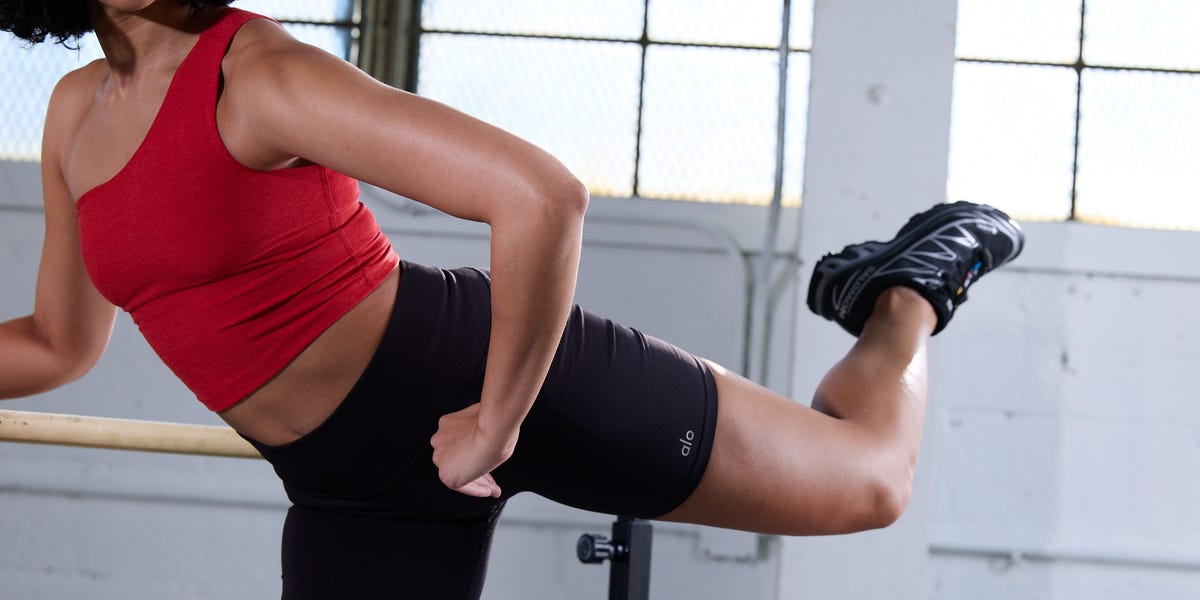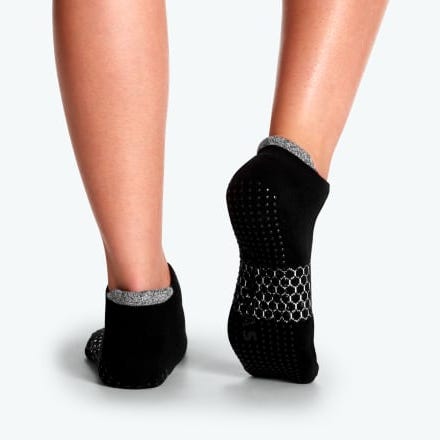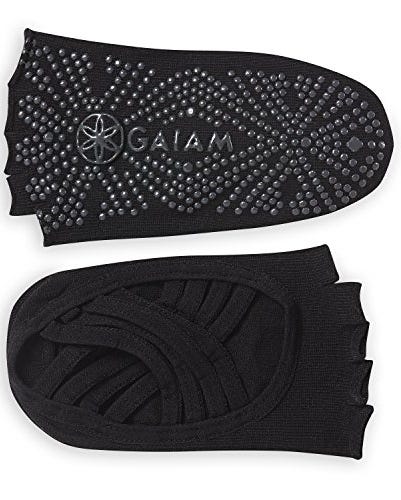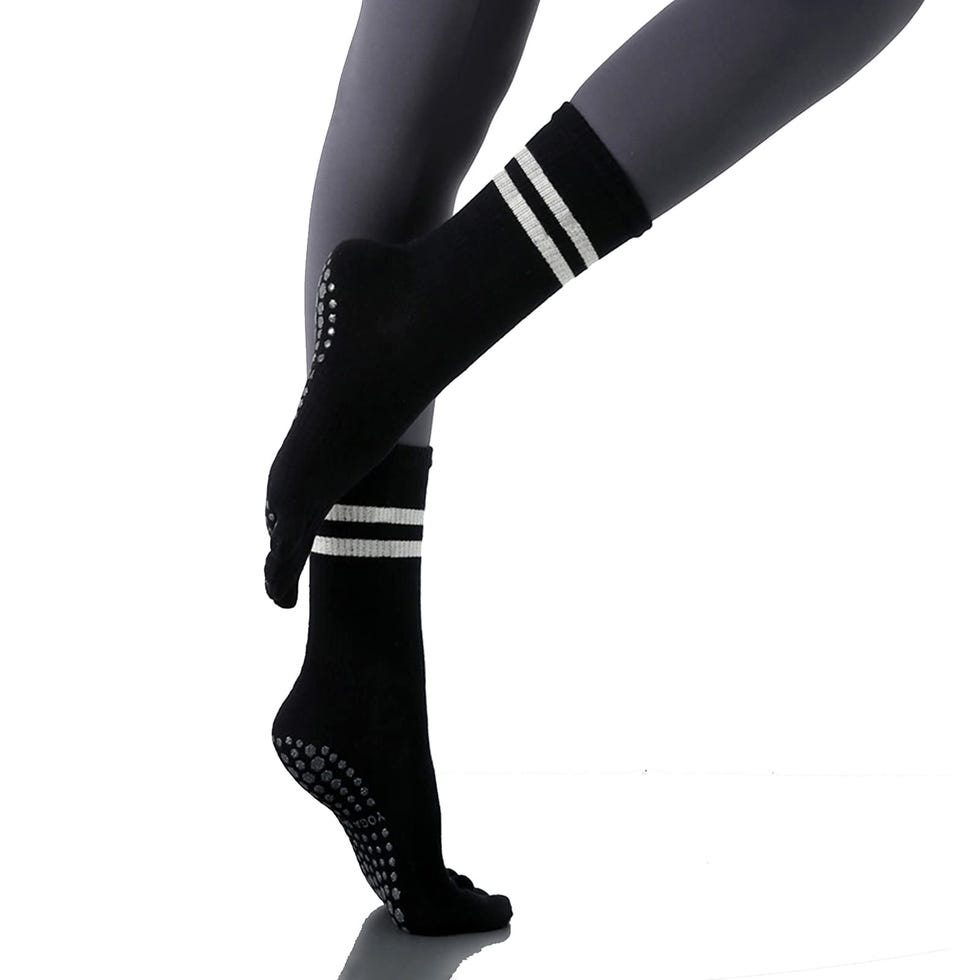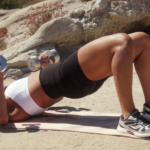If there’s one thing to know about me, it’s that I am a huge proponent of barre. This low-impact modality—created by a ballerina and a mix between Pilates, yoga, and strength training—is one sure-fire way to challenge yourself and work muscles you didn’t know you had, all while set to a killer playlist that keeps you motivated.
I never really felt at home in group fitness classes until I had my first session at Barre3. Showing up to the airy studio, I was greeted by smiling faces and asked if I had any injuries my instructor should know about. (A major thing I love about barre: That there are *plenty* of modifications for all kinds of needs.) I grabbed my light weights, resistance bands, and a towel for good measure, and by the time my 45 minute candlelight class was over, I had pulsed, plied, and squatted my way through an energizing full-body workout—and I was hooked.
Meet the experts: Katelyn DiGiorgio is the VP of training and technique and master teacher trainer at Pure Barre. Kara Liotta, CPT, is the co-founder of KKSWEAT, a barre and HIIT studio in New York City. Rachelle Reed, PhD, is an exercise scientist and Pure Barre instructor based in Athens, GA.
Whether you’re a fitness class vet or a total newbie like I was, there’s something for everyone at a barre class. Convinced to give it a try? Here’s what you can expect in your first class.
What To Expect In A Barre Workout Class
Each barre class is roughly 45 to 60 minutes and designed to be a full-body, muscle endurance workout (as I’ve definitely experienced). Typically, they’re broken into different sections that focus on major muscle groups including the arms, legs, glutes, and core.
“The muscles in each group are fatigued via small targeted movements, high numbers of repetitions, and light weight or resistance,” says DiGiorgio. Think: pulsing in a squat to target the glutes and quads, cranking out as many triceps kickbacks as possible with three-pound weights, or moving through a lively plank sequence.
“Barre class is a workout technique inspired by elements of ballet, yoga, and Pilates,” says DiGiorgio. “It focuses on low-impact, high-intensity movements designed to strengthen your body in ways that few other workouts can.”
One way barre achieves that intensity is through isometric exercises, or holding a static position. “The idea here is that holding something in good form—and making it through the whole series that way—is building time under tension,” says Rachelle Reed, PhD, an exercise scientist and a Pure Barre instructor for over ten years. “It’s a way to use the principle of progressive overload to build strength without lifting weights.”
In addition to building strength, this full-body workout also develops agility and flexibility by incorporating stretching, DiGiorgio adds. In some classes, you’ll use just the barre (or equivalent like a countertop or chair back) and your body weight to churn out rep after rep of muscle-burning move, while others incorporate tools like resistance bands, sliders, ankle weights, free weights, exercise balls, and more. But don’t let the fancy equipment fool you. Barre is a very practical workout. “I think of barre as being in the category of functional fitness because so many things that we do in barre mimic movements that we need to do in real life,” says Reed.
Benefits Of Barre Workouts
There are many perks that come with dabbling in barre classes to supplement your other training or making them your go-to workouts.
- Increased flexibility and mobility. Borrowing from ballet and all the flexibility that dancers need, barre classes also can help improve your stretchiness. “Some exercises can involve a bit of mobility, particularly in your hips,” says Kara Liotta, the co-founder of KKSWEAT. She also notes that beyond the specific ballet-inspired moves, you’ll also get a fair amount of stretching in most Barre workouts to stretch out the muscles you’ll be exhausting.
- Increased muscle strength. Any form of resistance training—calisthenics, weight lifting, and barre—will increase muscle mass. Studies show that yes, intensity or added weight builds muscle, but so can volume, which is what barre is all about. Oh, and because so many of the moves you’ll work through in class get your abs and back fired up, you can bet you’ll sculpt a stronger, more defined core, DiGiorgio adds. (And, BTW, doing strength training and building muscle also has benefits for your bone density.)
- Improved endurance. “Barre workouts are all about endurance, form, and repetition,” says Liotta. “You hold positions for a long time and exhaust reps, but with minimal weight.” Because you are spending a good amount of time in each shape to really wear out the muscles, you also can truly feel what part of your body you are supposed to be activating and strengthening.
- They’re gentle on joints. Barre classes are low-impact, which can reduce the risk of injury and help if you are already injured. “Many people are working with injuries and still want a solid physical challenge without feeling like they have to modify everything,” says Liotta. “Barre is low-impact because there is no jumping whatsoever in a traditional barre workout.” That also makes it a great option for pre- and postnatal women, DiGiorgio says.
- Better posture. So many of the moves in a barre class also target your abs and core. So not only can you work toward a stronger, more defined core, you’ll also be gaining solid strength to improve your posture, balance, and overall agility.
- Improved lower back pain. Because of barre’s core-strengthening and posture-improving abilities, it can lead to reduced lower back pain, says Reed.
- Great for cross training. You don’t have to go all in on barre to feel the effects. Even if your primary focus is on getting ready for a race, barre class can be a great form of cross-training to maintain strength and well-rounded fitness, DiGiorgio says.
- Strengthened pelvic floor. Another part of your body that barre works? Your pelvic floor, says Reed. For this reason, she also says it could be a good option for pregnant people looking to get active, assuming they talk to their doctors first. “I taught and took bar throughout both of my pregnancies and postpartum experiences,” says Reed. “Because it’s low impact and so good for pelvic floor training, I felt so strong and prepared for both.” Psst: One small, observational study from 2023 found that—among the 25 women with urinary incontinence issues they surveyed—all saw significant improvement after ten Pure Barre sessions.
How Barre Compares To Other Workouts
For starters, barre is for everyone, and you don’t have to be a dancer or super-fit to do it. “The community is made of people who have tried every fitness class ever created, as well as those just starting their fitness journey,” says DiGiorgio. “Unlike many exercise programs, which require a high level of physical fitness or prior expertise, barre is very beginner-friendly and adaptable to different skill sets and ability levels.”
Still, it may take a few classes before you hit your groove at the barre. “Class moves quickly, and can be challenging, since you’ll utilize muscles you never knew you had,” says DiGiorgio. “But you’ll get the hang of it after three or four classes, and you’ll generally see results in just eight to 10.”
In a barre class, expect to be moving to upbeat music, unlike Pilates, where you will be mostly relying on breath cues. This has its benefits, says Reed. Working out to music not only helps you psychologically, making your rate of perceived exertion feel lower, but it could also help you physically by boosting muscle activation, per a 2021 review in the Journal of Functional Morphology and Kinesiology.
Plus, the newer “fusion” variations of barre classes have different goals and may remind you of other modalities you’ve tried. Pure Barre’s Pure Empower class, for example, combines traditional barre moves with interval training, so you get your heart rate up to get your cardio in, too. Other fusion classes, meanwhile, use more weights and resistance tools to up the ante, like Barre3’s Strength class.
What To Wear To Barre Class
While workout outfits are totally based on personal preference, DiGiorgio recommends wearing leggings or capris that you feel comfortable in and a workout tank or T-shirt to barre class.
Wearing clothes that fit close to your body also helps your instructor get a better view of your form (if you’re taking a Zoom or Google Hangout class or have access to an IRL instructor) throughout class so they can give you advice on any necessary adjustments.
You’ll also want to wear sticky socks to prevent your feet from sliding. (Trust me, this one is essential.)
Here are a few great grippy barre socks to get you started:
Best Barre Workouts To Try At Home
One of the best things about barre? That you can do it almost anywhere—yes, even without a bar. Here are the best at-home barre workouts to sweat and move when you want:
- KKSWEAT— Liotta’s platform, KKSWEAT, offers live streaming, on demand, and in-person classes in her NYC studio. Online, you can purchase a 50-minute workout for $28, which gets you a 12-hour rental. KKSWEAT also has a QUICKSWEAT option that gets you unlimited access to the video library of express-style, 30-minute workouts.
- Physique 57 — With Physique 57, you can work your way up through various levels of barre workouts. Classes include sculpt, power sculpt, back body sculpt, core lab, and prenatal. Plus, the online platform also offers HIIT classes, dance classes, and Pilates. Subscriptions start at $24.99 per month. Check out their Instagram, too, for live classes.
- Barre3 — For $8.25 a month, you can access Barre3’s catalogue of hundreds of on-demand workouts from introductory classes to travel-friendly options to prenatal videos. B3 blends strength, cardio, and mindfulness, so you can work your body and your mind. You’ll also find exclusive breathwork, meditation, and stretching content on the platform too.
- Action Jacquelyn — Jacquelyn’s YouTube page has 150K follows, so you know she’s doing something right. You’ll get tons of free (!!) videos that range from a quick five minutes to 30 minutes and cover everything from a barre booty lift series to a full-body barre workout. She also offers yoga and Pilates videos, and 30-day challenges.
- Pure Barre — You can lift, tone, and burn with this total body workout anywhere, anytime. There are live and recorded workouts available to bring the studio experience to your home. Try it free for 7 days. After that, the on-demand subscription is $29.99 per month and also includes access to popular classes from Rumble, Cyclebar, Club Pilates, and more. Keep an eye out for DiGiorgio leading the workout, too.
- Exhale — Part spa and part fitness studio, Exhale offers challenging barre classes on demand and streamed live for a community sweat. There are also yoga and cardio modalities. Try it for 30 days for $99, subscribe to virtual classes only for $29.99 monthly, or grab an unlimited FIT membership for $209 per month, which includes spa service discounts and access to on-demand and in-person classes.
Barre Class Form Tips
There’s a lot of new lingo to learn when you step in the studio. Here are the terms you need to know to keep your form on point and make the most of your hard work.
- Pulse: In your first class, “one of the more challenging form essentials to grasp is the idea of small, controlled movements,” says DiGiorgio. “When you hear your teacher say pulse, for example, that literally means just move an inch up and down.” The goal here is to focus on contracting the target muscle, which requires keeping your range of motion controlled, precise, and small.
- Shaking: Don’t be alarmed during your first barre class if you’re trying to hold a position and your leg suddenly starts shaking. It’s par for the course in this modality. Remember how barre is all about high-volume repetitions, small movements, and isometric holds? “As your muscles fatigue and start running out of energy, they get shaky and less stable,” says Reed, meaning holding that position just got a whole lot harder. Shaking means you’re doing the move right.
- Tuck your tailbone: If the instructor says this, or have a “heavy tailbone,” draw your abs inward and roll your hips under slightly to create a neutral spine, says DiGiorgio. This position promotes core engagement, and comes up a lot throughout class.
Remember, if you don’t catch on after your first try, don’t get discouraged! You’ll learn the lingo and moves after a few classes, DiGiorgio says.
Olivia Luppino is an editorial assistant at Women’s Health where she covers health and fitness. She previously wrote for The Cut, POPSUGAR, and Salon and has written about everything from New York Fashion Week to dating app trends to the United States Women’s National Soccer team (a.k.a. her heroes). When she isn’t writing, Olivia is likely catching up on Bravo shows or running late to barre class.
Read the full article here


